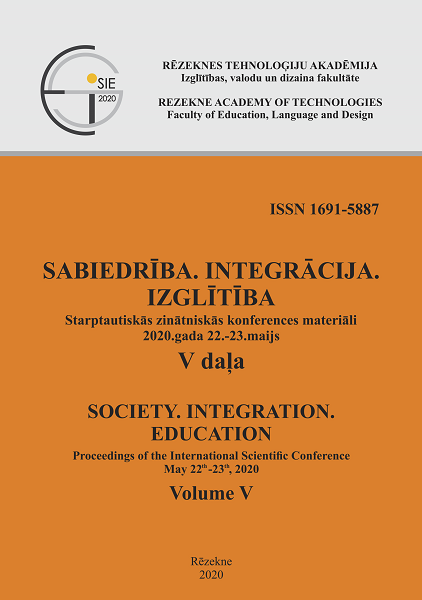VISUAL STREET ART: MESSAGES OF RIGA STENCIL GRAFFITI
DOI:
https://doi.org/10.17770/sie2020vol5.4807Keywords:
graffiti, ideology, social semiotics, subculture, visual messagesAbstract
The modern urban space is inevitably the site of different striking messages from advertisement to graffiti. The last are used as an alternative medium of subculture, even if majority of the public fails to notice it or else interprets it, contrary to culture’s ordered world of meanings, as chaotic “dirt” more closely related to nature than culture. The discourse of messages found in the public space - on the façades of surfaces forming urban space, can be interpreted in a countercultural code and is for the subculture of graffiti itself, a battle taking place for the aesthetization of the public space. This is the answer provided by the rebellious sons to the “fathers of the city”, who possess money and power with which to design urban public space using architectural means. The generation of sons, who are excluded from this real estate discourse due to a lack of means, put into play the only thing they own, i.e. their body, which they subject to the danger of imprisonment, because graffiti is an illegal activity, which in legal terms is interpreted as vandalism, a view that also prevails within the mass media. In this paper we analyze the meaning of visual messages of Riga stencil graffiti using social semiotics' methodology (Kress & Leewen, 1996; Jewitt & Oyama, 2004). We find that the utilization of the street as an alternative and independent medium in the form of civil disobedience manifested through the translation of radical political ideas, thus to a certain extent performing the work of propaganda, is an example of creative idealism.
Downloads
References
Bennett, A. (1999). Subcultures or Neo-tribes? Rethinking the Relationship Between Youth, Style and Musical Taste. Sociology, 33, 599-617. DOI: 10.1177/S0038038599000371
Boluža, I. (2013). Is Graffiti Art a Crime or a Protest of the Society against Law Enforcement. In Public Security Studies. (69-73). vol.2.
Bordijārs, Ž. (2000). Simulācija un simulakri. Rīga: Omnia mea.
Bourdieu, P. (1991). Language and Symbolic Power. Retrieved from monoskop.org/images/4/43/Bourdieu_Pierre_Language_and_Symbolic_Power_1991.pdf
Colebrook, C. (2004). Irony. New York: Routledge.
Cultural Crossroads, Vol. 13. (2019). Riga: LKU.
Derrida, J. (1997). Of Grammatology. Baltimore: John Hopkins University Press.
Hebdige, D. (1998). Subculture: the Meaning of Style. London: Routledge.
Jewitt, C. & Oyama, R. (2004). Visual Meaning: A Social Semiotic Approach. In: Van Leewen, T. and C.Jewitt, The Handbook of Visual Analysis. London: Sage.
Jordan, T. (2002). Activism! London: Foci.
Kozlovs, N. (2004). Artist’s Role in the Local Context: Latvian Case. In S. Krese (Ed.), Artists as Producers. Transformation of Public Space. (5-8). Riga: LMC.
Kozlovs, N. (2005). Transformation of Public Space; Artist’s Role. In R.Šmite (Ed.), Reader on Mixed Reality “Space and Perception” (66-71). Riga: RIXC.
Kress, G., & Van Leewen, T. (1996). Reading images. New York: Routledge.
Lannert, C. (2015). The Perpetuation of Graffiti Art Subculture. In Butler Journal of Undergraduate Research. (47-66). Vol. 1. Retrieved from https://digitalcommons.butler.edu/bjur/vol1/iss1/5
Lefebvre, A. (2015). Proizvodstvo prostranstva. Moskva: Strelka press.
Markoff, J. (2005). What the Dormouse Said: How the Sixties Counterculture Shaped the Personal Computer Industry. New York: Penguin.
Routledge, P. (1997). The Imagineering of Resistance: Pollok Free State and the Practice of Postmodern Politics. In Transactions of the Institute of British Geographers. (359-376). Vol.3
Toro, H. D. (2004). Voldena jeb Dzīve mežā. Rīga: Zvaigzne ABC.
Turchine, V. (1993). Po labirintam avangarda. Moscow: MGU.
Turner, F. (2006). From Counterculture to Cyberculture. Chicago: University of Chicago
Velikonja, M. (2019). Post-Socialist Political Graffiti in the Balkans and Central Europe. London: Routledge.
Voloshinov, V. (1930). Marksizm i filosofija jazyka. Retrieved from http://www2.unil.ch/slav/ling/textes/VOLOSHINOV-29/I-1.html#1


